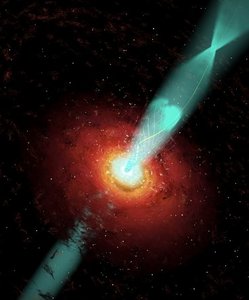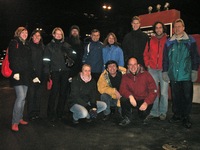
Blazars are a class of active galactic nuclei characterized by an extremely variable X-ray and/or gamma-ray emission. Although we know that every blazar with strong gamma-ray emission contains a prominent jet of magnetized plasma flowing out of the nucleus at near-light speeds, astrophysicists have thus far failed to determine how and where the jet produces the gamma-rays and X-rays. Understanding this will help us to constrain the jet formation mechanism and the physical conditions close to the black hole. The successful launch of NASA's Fermi (formerly GLAST) mission will provide an almost continuous monitoring of several tens of bright blazars in the gamma-ray domain. These observations together with complementary multi-wavelength measurements by existing (MAGIC, AGILE, INTEGRAL, XMM-Newton and Swift) or upcoming facilities like Planck will open a new era in the characterization of the spectral evolution of strong outbursts. Our Team composed of both theoreticians and observers has the objective to properly interpret and model these unprecedented observations. The Team will work in three complementary areas:
Since the low-energy emission component of blazars from the radio to the optical range is well understood in terms of synchrotron emission in propagating shock waves, we first plan to investigate the contribution of the necessarily associated synchrotron self-Compton (SSC) emission at high-energies. We will then assess whether another process has to be invoked in addition for a full description of the observations. The ISSI Team meetings will result in the publication of a refined model for the SSC emission of shock waves in a relativistic jet, as well as a paper on the application of this model to observations. If successful, the same methodology will be applied on the longer-term to several other jet sources, possibly including also microquasars and gamma-ray bursts and shall result in a much deeper understanding of the physical conditions in various kinds of relativistic jets.
For additional information, see the project proposal.
We plan to have two Team meetings at the ISSI in Bern each lasting one week. The first meeting will be held from December 9 to December 13, 2008 and the second before the end of 2010. The first meeting would start with two days of presentations of the work of the participants relevant to the project and on the review in a Journal-Club way of other publications in the field. The three remaining days would be devoted to the definition of the objectives and the work packages in the three areas of the project: observational strategy, theoretical developments and modelization (i.e. how to parameterize and apply the model to the data). This will be done by splinter meetings followed by a reporting of the outcome to the complete team. The last afternoon will be used to summarize the meeting results and to define the organization of the work to be conducted separately, but with frequent e-mail and teleconference contact, by the Team members. The second meeting at the ISSI in Bern will serve to present the work that has been achieved and to discuss further the points which are the most critical for the success of the project as a whole. The advancement of the publications shall also be discussed and the final details settled.
9:00 Welcome and agenda overview 9:15 Blazar emission modeling: an observer's view [EV] 9:45 Origin of hard X-ray and gamma-ray emission in Cen A [VB] 10:15 COFFEE BREAK 10:45 The first year of Planck operations [AL] 11:15 Connection between gamma-ray emission and mm flares in Fermi/LAT blazars [JLT] 11:45 Observations of Variability of Flux, Polarization, and Jet Structure [AM for SJ] 12:15 LUNCH BREAK 14:00 The high-energy emission of 3C 273 [SS] 14:30 MAGIC and MWL observations of 3C 279 in 2007 and 2009 [EL] 15:00 Explanations of Multi-waveband Variability [AM] 15:30 TEA BREAK 16:00 Particle acceleration timescales in blazar jets [JT] 16:30 Multiple Compton scattering and the blazar sequence [CB] 17:00 Shock-in-jet modeling: status and prospects [MT] 17:30 END OF SESSION
9:00 Agenda overview 9:10 Splinter meetings on observation/phenomenology and theory/modeling [2 groups] 10:30 COFFEE BREAK 11:00 Splinter meetings wrap-up [2 groups] 11:30 Outcome of splinter meeting on observation/phenomenology and discussion [all] 12:00 Outcome of splinter meeting on theory/modeling and discussion [all] 12:30 LUNCH BREAK 14:00 Splinter meetings on observation/phenomenology and theory/modeling [2 groups] 15:00 Splinter meetings wrap-up [2 groups] 15:20 Outcome of splinter meeting on observation/phenomenology and discussion [all] 15:40 Outcome of splinter meeting on theory/modeling and discussion [all] 16:00 END OF SESSION => some time left to visit and shop in Bern!
9:00 Agenda overview 9:10 Splinter meetings on observation/phenomenology and theory/modeling [2 groups] 10:00 Outcome of splinter meeting on observation/phenomenology and discussion [all] 10:15 Outcome of splinter meeting on theory/modeling and discussion [all] 10:30 COFFEE BREAK 11:00 Meeting wrap-up: definition of work and milestones [all] 12:00 END OF MEETING
14:00 Welcome
14:10 [ Metsahovi + Planck observations ? ] [AL]
14:40 Long-term radio variability of quasars and BLOs [TH]
15:10 High frequency VLBA observations of gamma-ray blazars [SJ]
15:40 COFFEE BREAK
16:00 The multi-wavelength variability of 3C 273 [SS]
16:30 Multiwaveband Observations and Multi-zone Models [AM]
17:00 What can be learned from inverse Compton scattering in [CB]
compact radio sources?
17:30 END OF SESSION
9:00 Agenda overview
9:10 Blazar emission modeling: an observer's view [EV]
9:40 IR-to-radio shock-in-jet modeling of 3C 273 and GRS 1915+105.
The role of a low-energy cut in the electron distribution [MT]
10:10 Shock-in-jet modeling of low- and high-activity in Cyg X-3 [JM]
10:40 COFFEE BREAK
11:00 Synchrotron and SSC modeling of 3C 279
and newest AGN results from MAGIC [EL]
11:30 [ Fermi + other High-Energy missions ? ] [VB]
12:00 Use of Fermi for constraining blazar physics [MG]
12:30 LUNCH
14:00 Modelisation of TeV blazars by a time dependent stratified [TB]
jet model - Application to the big flare of PKS 2155-304
14:30 Short presentations or reports on other relevant studies [all]
15:40 COFFEE BREAK
16:00 Definition of the main objectives of the project [all]
17:30 END OF SESSION
9:00 Project strategy on: observations and theory [2 groups]
10:30 COFFEE BREAK
11:00 Splinter meetings wrap-up [2 groups]
11:30 Outcome of splinter meeting on observations [all]
12:00 Outcome of splinter meeting on theory [all]
12:30 LUNCH
14:00 Start of Guided Tour of the Old Town at the Clock Tour
14:30 Visit of the Clock Tower
15:00 Second part of the Guided Tour of the Old Town
16:00 Free time for a visit of the Einstein House or the Einstein Museum
(/!\ closing at 17:00) or shopping, etc.
18:00 END OF AFTERNOON
9:00 Project def. on: observations, modeling and theory [3 groups] 10:30 COFFEE BREAK 11:00 Splinter meetings wrap-up [3 groups] 11:30 Outcome of splinter meeting on observations [all] 11:50 Outcome of splinter meeting on modeling [all] 12:10 Outcome of splinter meeting on theory [all] 12:30 LUNCH 14:00 Work packages on: observations, modeling and theory [3 groups] 15:30 COFFEE BREAK 16:00 Splinter meetings wrap-up [3 groups] 16:20 Outcome of splinter meeting on observations [all] 16:40 Outcome of splinter meeting on modeling [all] 17:00 Outcome of splinter meeting on theory [all] 17:20 Summary and conclusion of the session 17:30 END OF SESSION
9:00 Work assignment: observations, modeling and theory [3 groups]
10:30 COFFEE BREAK
11:00 Splinter meetings wrap-up [3 groups]
11:30 Outcome of splinter meeting on observations [all]
11:50 Outcome of splinter meeting on modeling [all]
12:10 Outcome of splinter meeting on theory [all]
12:30 LUNCH
14:00 Definition of the project schedule and milestones [all]
14:30 Discussion on the project coordination and reporting,
as well as dates and objectives for the next meeting [all]
15:00 END OF MEETING